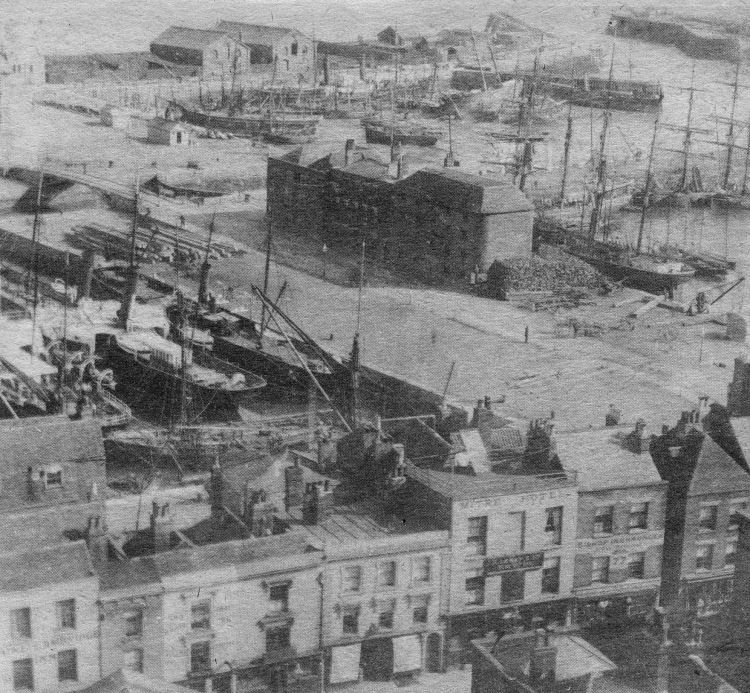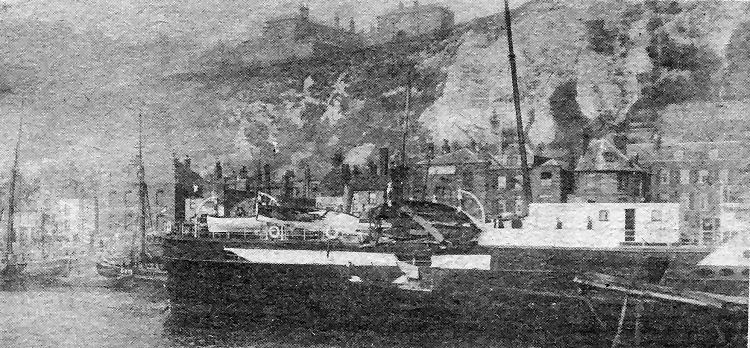Page Updated:- Sunday, 07 March, 2021. |
|||||
 Published in the South Kent Gazette, 27 February, 1980. A PERAMBULATION OF THE TOWN, PORT AND FORTRESS. PART 62.
THE GRAND SHAFT The Grand Military Shaft, an arched passage with steps, leading from the lower part of Snargate Street up to the Western Heights, was one of the conceptions of Sir Thomas Hyde Page, military engineer, the construction of which was commenced in 1779, but not completed until 1802. The long arched passage, leading from the guard house near the Wesleyan chapel, terminates at the bottom of a perpendicular shaft, up which there is a three-fold spiral flight of 140 steps, one section of the way up being for officers and ladies, one for “women,“ and one for soldiers. Prom the top of the spiral flight there are 59 more steps, leading up into the barrack yard. At one time the Shaft was allowed to be used as practically a public approach to the Western Heights. Visitors regarded the ascent as one of the things to be “done.“ When they were first constructed they created great interest among the townspeople and soldiers, bets being often made as to how quickly they could be climbed. Mr Leith, of Walmer, for a wager, rode his horse up these steps, in the year 1812. A sentry was always mounted at the Snargate Street entrance of the Shaft when the Western Heights were garrisoned and there was a guard ready to be turned out in the adjoining guardroom. This guard was a familiar feature of this part of the street from the militant days of Napoleon Bonaparte.
FOUNDRY AND DYE-WORKS A large block on the cliff side, from Nos. 96 to 99, was, about the year 1825, devoted to an ironmonger’s business and an iron foundry, carried on by Messrs Poole and Alderton. This business sprang up when the introduction of steam navigation called for the local aid of the flitter and the boilermaker. There were extensive caves in the cliffs at the rear of these premises, which were there before .the days of the foundry, and were probably used as stores in connection with the Royal Victualling Yard, which was on the quayside opposite. When the London, Chatham and Dover Railway established their own steam packet yard, this foundry declined. During the successful days of the Snargate Street ironworks, Mr Edward Poole, its principal proprietor, was mayor of Dover from November, 1840, to November, 1842. The premises were subsequently used by Mr Philip Stiff, partly as a foundry, known as the Phoenix Ironworks, and partly as a builder’s workshop. Afterwards they were the works of Messrs John Scott and Son, Ltd., dyers and cleaners. These were started in 1852 by Mr J. Scott, sen., at No. 40 Snargate Street. Part of the dye works was at No. 95, where Mr William Thorpe in the mid 1840s established the business of a butcher, being succeeded by Mr H. W. Thorpe, a Dover magistrate, and the senior councillor in the Corporation, when he died in 1911. Another fitter’s yard, just below, which was occupied by Messrs A. L. Thomas and Sons, and afterwards by the Dover Engineering Works, Ltd., was very busy during the Great War in Naval repair work keeping up a tradition dating to the beginning of the last century, on a smaller scale, by Mr Waters. It was later a garage and motor works. An old Snargate Street inn, “The Mitre,“ was transferred to the adjoining premises when its original home on the other side was pulled down in 1930.

The western docks, in 1880, with Snargate Street in the foreground showing some of the properties swept away when Commercial Quay was enlarged. The buildings now-gone include those of the Duke of Cambridge Inn, left. The Grand Shaft Inn, the Mitre Hotel and Bishop, the ironmonger. On Union Quay, centre, are the old warehouses and offices of George Hammond. Some of the early cross-Channel paddle steamers are moored in the Wellington Dock and numerous sailing ships, which brought coal or sawn timber to the port, are in the Granville Dock and the tidal dock.

The above picture, gives another view of Commercial Quay with the Pentside Baptist Chapel behind the DB 33 fishing boat, Clouts the ironmongers in the centre and, behind Snargate Street on the right the Bellevue tea gardens — the terraced back garden of Court’s wine vaults. In the foreground is a damaged paddle steamer.
|
|||||
|
If anyone should have any a better picture than any on this page, or think I should add one they have, please email me at the following address:-
|
|||||
| LAST PAGE |
|
MENU PAGE |
|
NEXT PAGE | |